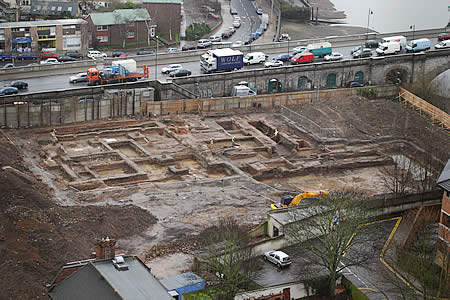Before work starts on a new building, archaeological excavations are revealing that it has a rich - and royal - heritage. Trial work at Kew Bridge House found the remains of several buildings dating from the 17th century onwards as well as finds from the Middle Ages. Now, following the demolition of a modern office block, excavations are exploring these buildings and exploring what went on at the site in the Middle Ages.

In 1747 the famous map maker John Rocque illustrated an ‘L’ shaped building on the eastern edge of the site. This building was extended in the late 18th and 19th centuries and eventually used as a malthouse, which has royal connections.
The excavations have found the remains of this building to which a wing was later added. The foundations from an earlier, late 17th or early 18th century, building, were found underneath.
The earliest activity on the site is not, though, recorded by history. The excavations have confirmed the hints of medieval activity. Pits and ditches have been found and it is thought that most of these will be medieval in date. The ditches may be from field systems lying to the east of the medieval town of Brentford and next to the River Thames.
Malt was used in making beer. The malthouse seems to have belonged to the Royal Brewery based in Brentford High Street. Many bottles and bottle tops with the Brewery’s crest have been found. At first the brewery, which dates back to the 18th century, was called the Red Lion Brewery. Its royal connection and its new name - the Royal Brewery - came about in 1828 after King William IV visited it and asked for its name to be changed.
The malthouse went out of use in the early 20th century, when the main buildings were demolished and their cellars filled in with rubbish. After that, a modern office block was built. The new development opens another chapter in the long and varied history of Kew Bridge House.
Credits
St George West London Limited commissioned CgMs Consulting and Wessex Archaeology to do the archaeological work for them. The excavations are being monitored by the Greater London Archaeology Advisory Service of English Heritage on behalf of the Council.